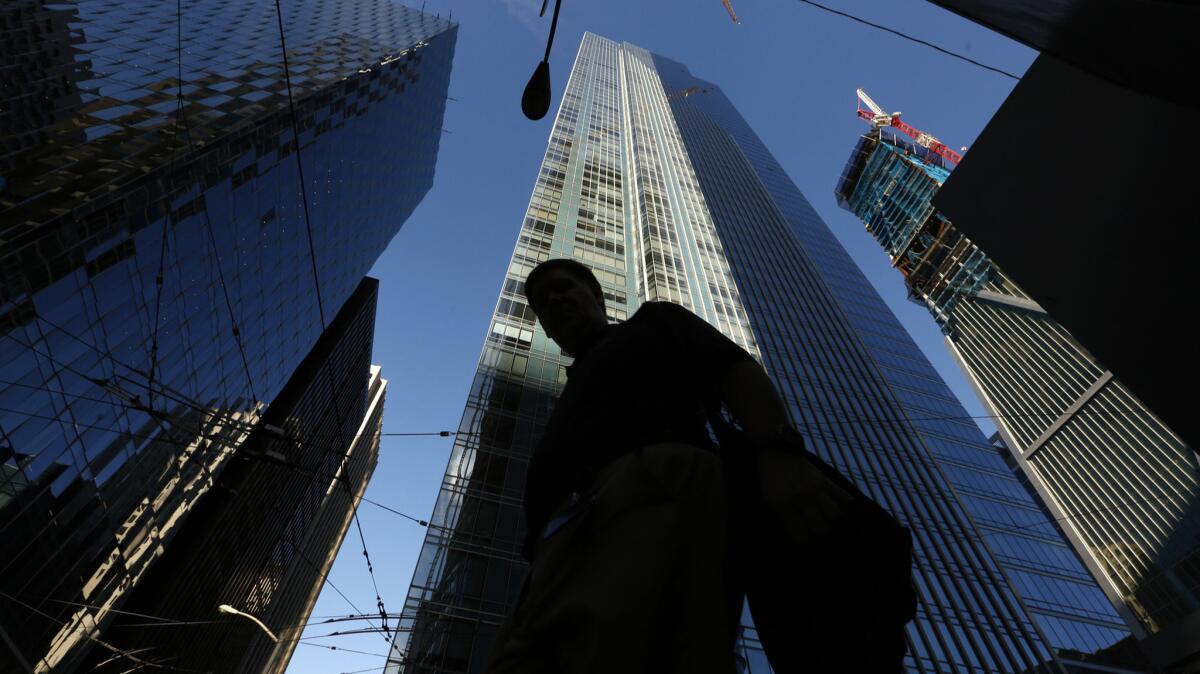San Francisco sues developer over sinking skyscraper

San Francisco has sued the developer of a sinking and leaning downtown high-rise that’s home to professional athletes and venture capitalists, claiming the company did not disclose the issues to prospective tenants before they moved, as the law requires.
The lawsuit, announced Thursday by the city attorney’s office, seeks unspecified damages from developer Mission Street Development LLC. The company has said it has complied with all state and local laws concerning the disclosure of information to possible homeowners.
According to the suit, plans for the 58-story Millennium Tower in San Francisco’s South of Market district forecast that the heavy building could sink as much as six inches as it settled into the earth.
But the tower has sunk 16 inches, and as it sinks, the building has begun to list — an estimated two to four inches at the structure’s base and 14 inches at the top.
The story of the sinking tower broke in early August, with a front-page report in the San Francisco Chronicle. Since then, it has been a news staple, playing out along a number of narrative plot lines — an engineering whodunit, a slow-motion real estate calamity and also a civic cautionary tale.
Fueled by a high-tech boom and a resultant runaway real estate market — and following the removal of a double-deck highway that ran along the waterfront but was badly damaged by the 1989 Loma Prieta earthquake — a forest of towers has been rising in San Francisco, especially in the SoMa district, where the Millennium Tower sits.
“Before they had sold a single condo, Mission Street Development LLC knew their building had sunk more than it was supposed to in its lifetime — and that it was still sinking,” City Atty. Dennis Herrera said in a news release. “Yet they didn’t tell the homebuyers, as they’re required to do so under the law. It’s that simple.”
While a paper trail of concern about potential settling dates to early 2009, even before the Millennium Tower was ready for occupancy, most residents of the building knew nothing about any issue with the foundation until they were summoned in early May to a private meeting in a lounge on the tower’s club level.
Identification was checked at the door. Residents were told that what they would hear must be kept a secret. A lawyer introduced a structural engineer who delivered, as resident Pamela Buttery and others recall, a simple statement that startled the packed room:
“The Millennium building is too heavy for its foundation.”
Not only had the tower settled by far more than the four to six inches originally forecast for the life of the building, but, “most importantly,” recalled Jerry Dodson, a retired patent lawyer and a vocal critic of the tower’s builders, the engineer said “it wasn’t stopping.”
Dodson has since heard estimates that the building could sink anywhere from 30 to 48 inches, “but nobody really knows.”
“My office has a duty to protect all the taxpayers of San Francisco,” Herrera said. “We are not going to sit by and allow a developer — or anyone else — to enrich themselves at the expense of others by hiding crucial information that they’re required by law to disclose. That gave the developer an unfair advantage against competitors, and it cheated homebuyers out of information they needed to make an informed decision.”
Dodson and several other condo owners in the tower blame Millennium Partners, the tower builders, for not driving foundational piles 200 feet down to bedrock, as was done with a 61-story skyscraper going up across the street. Instead, the builders relied on a concrete foundation attached to piles that were sunk into firmly compacted sand and mud about 60 to 90 feet below.
Such foundations are not uncommon in San Francisco, even on land fill — although many of the buildings so anchored are constructed with lighter, steel frames.
Millennium Partners, in turn, blames a massive construction project underway adjacent to the tower.
In preparing to build a multiagency transit center for rail and bus, the tower builders maintain, the Transbay Joint Powers Authority has lowered the underground water table beneath the tower, causing settlement.
Millennium Partners and the Transbay authority disagree with equal vigor. A class-action lawsuit by tenants has been filed against both groups.
High-rise construction projects also create piles of paperwork, and since the disclosure, no shortage of conflicting engineer studies and internal documents have come to light. Further geological surveys are in the works.
The situation has created factions within the vertical neighborhood, interviews reveal. There are those who would have preferred quiet negotiations with Millennium Partners, rather than endless media coverage. And there are those who want to take on the big players — Millennium Partners, the Transbay authority or both — with legal guns ablaze.
ALSO
San Francisco’s 58-story Millennium Tower is upscale, but literally sinking fast
Man charged in toddler’s stabbing death at mother’s workplace
Mexican businessman pleads guilty in 1995 cartel drug trafficking case
UPDATES:
2:45 p.m.: This article was updated with staff reporting, including background on the building’s development and tenant reactions.
This article was originally published at 12:50 p.m.
More to Read
Sign up for Essential California
The most important California stories and recommendations in your inbox every morning.
You may occasionally receive promotional content from the Los Angeles Times.












